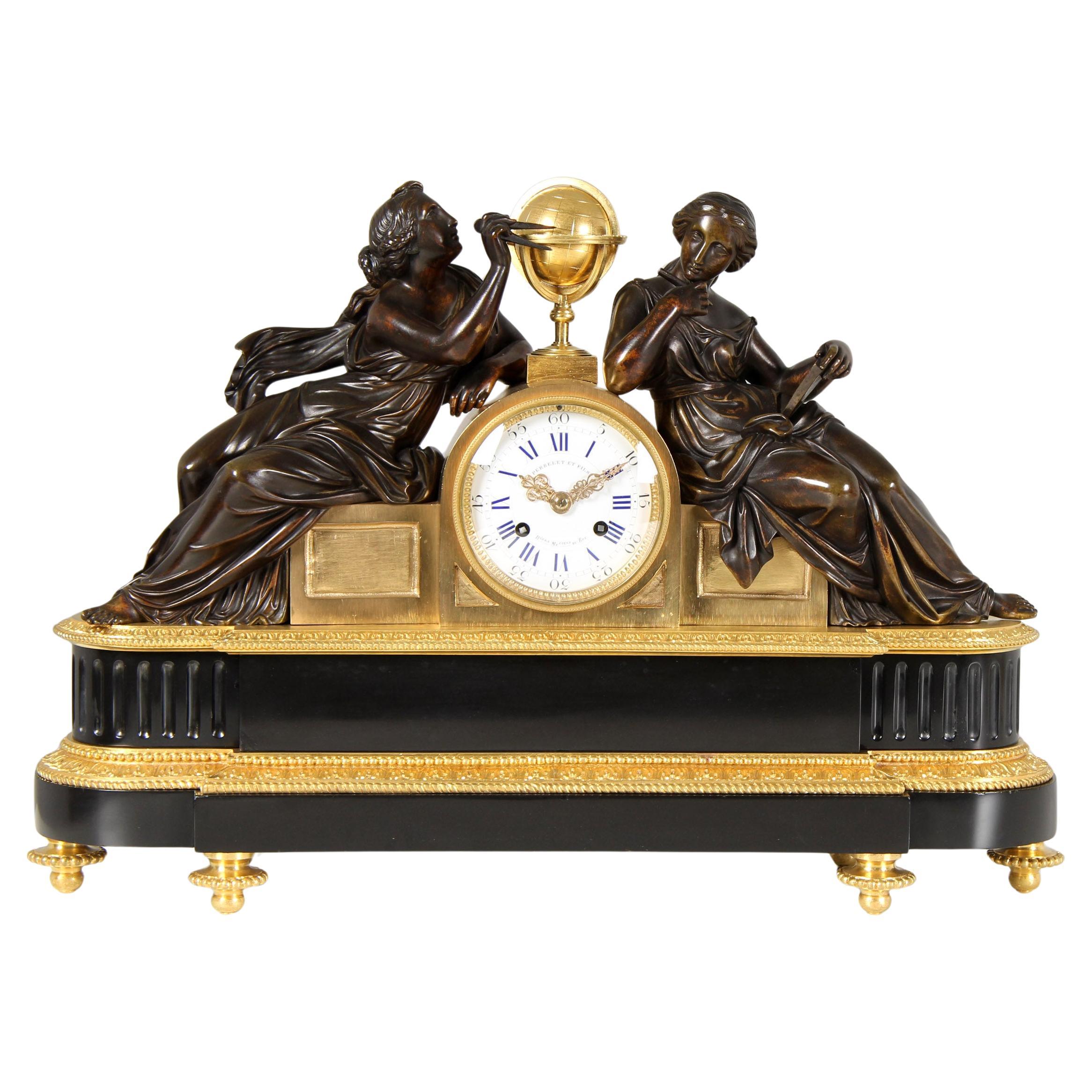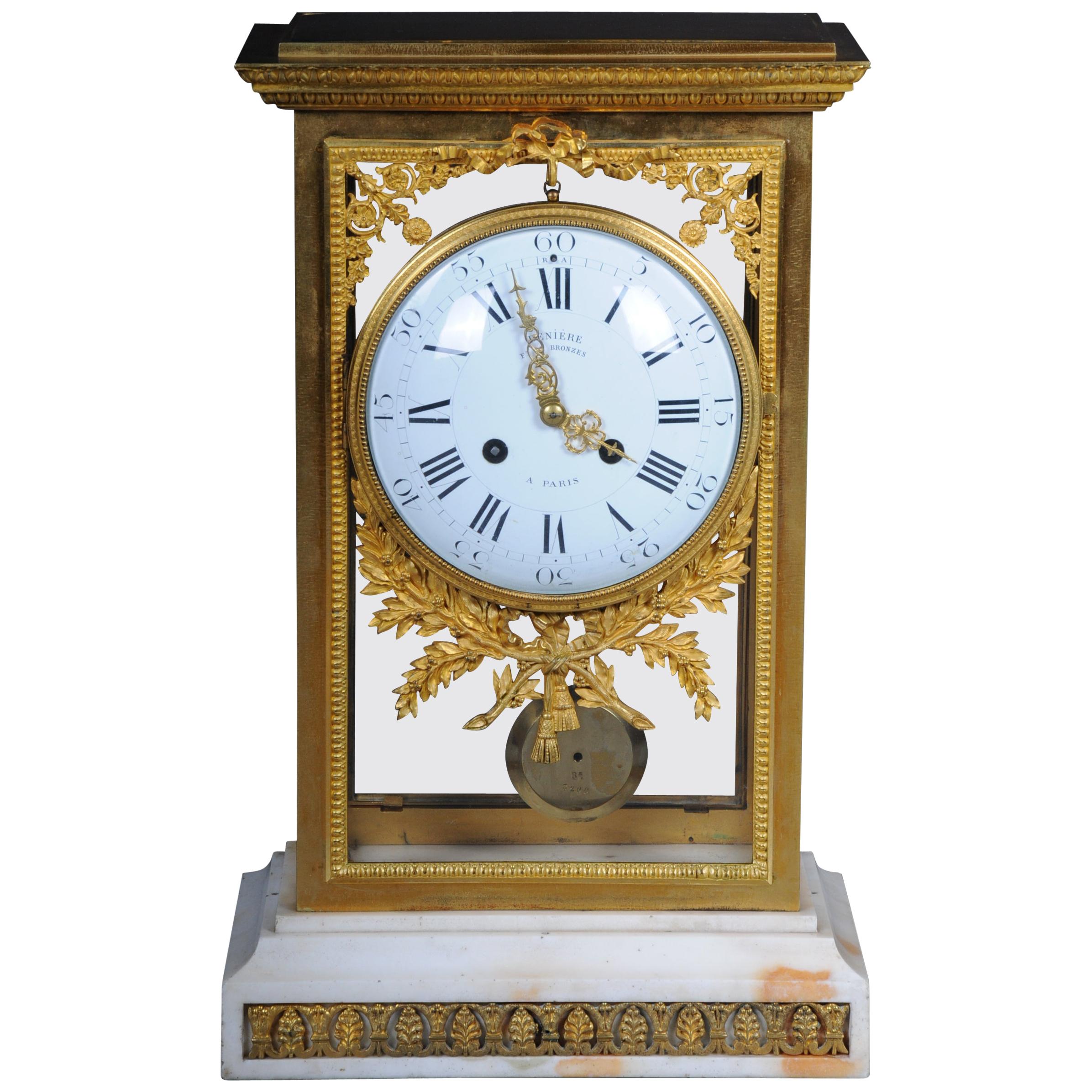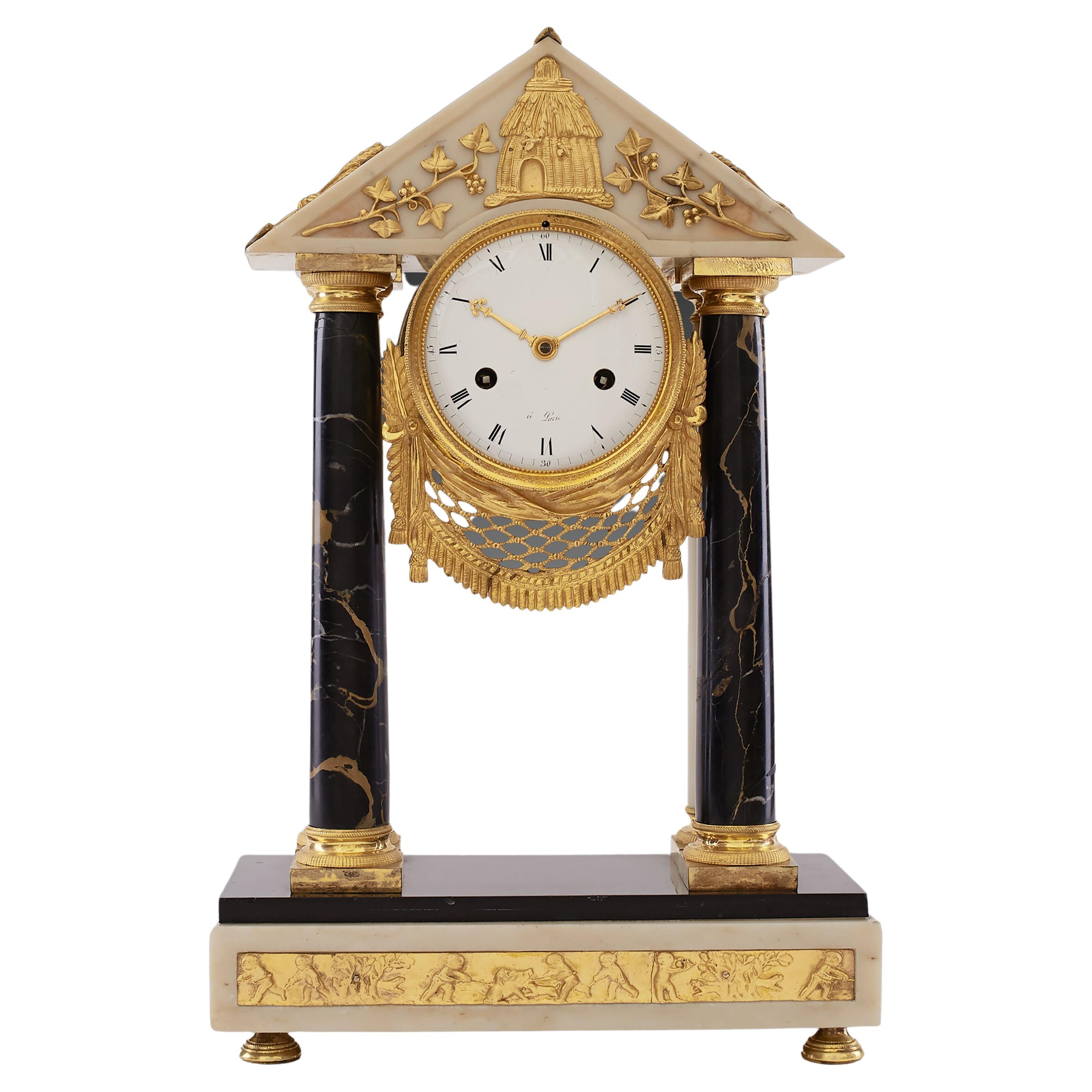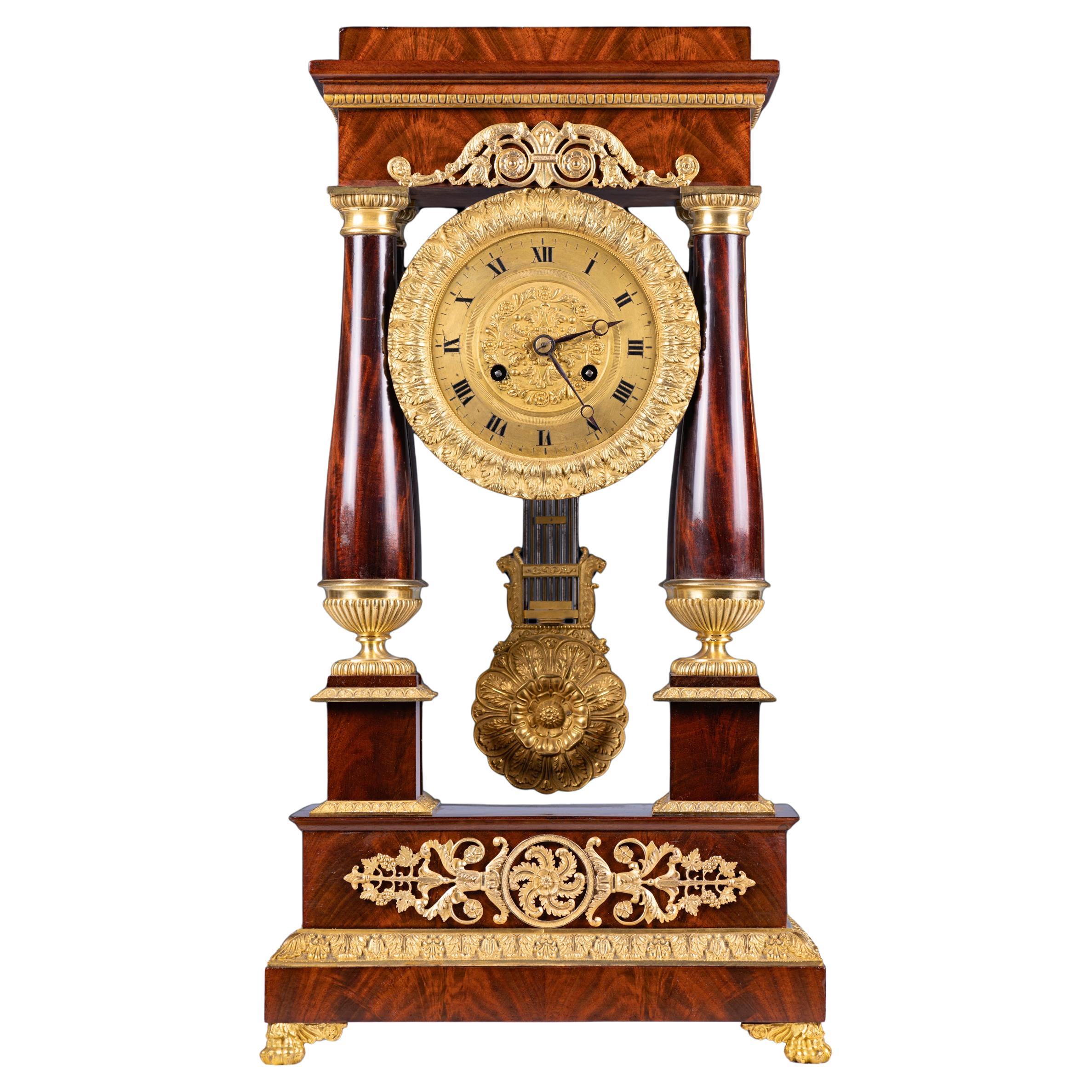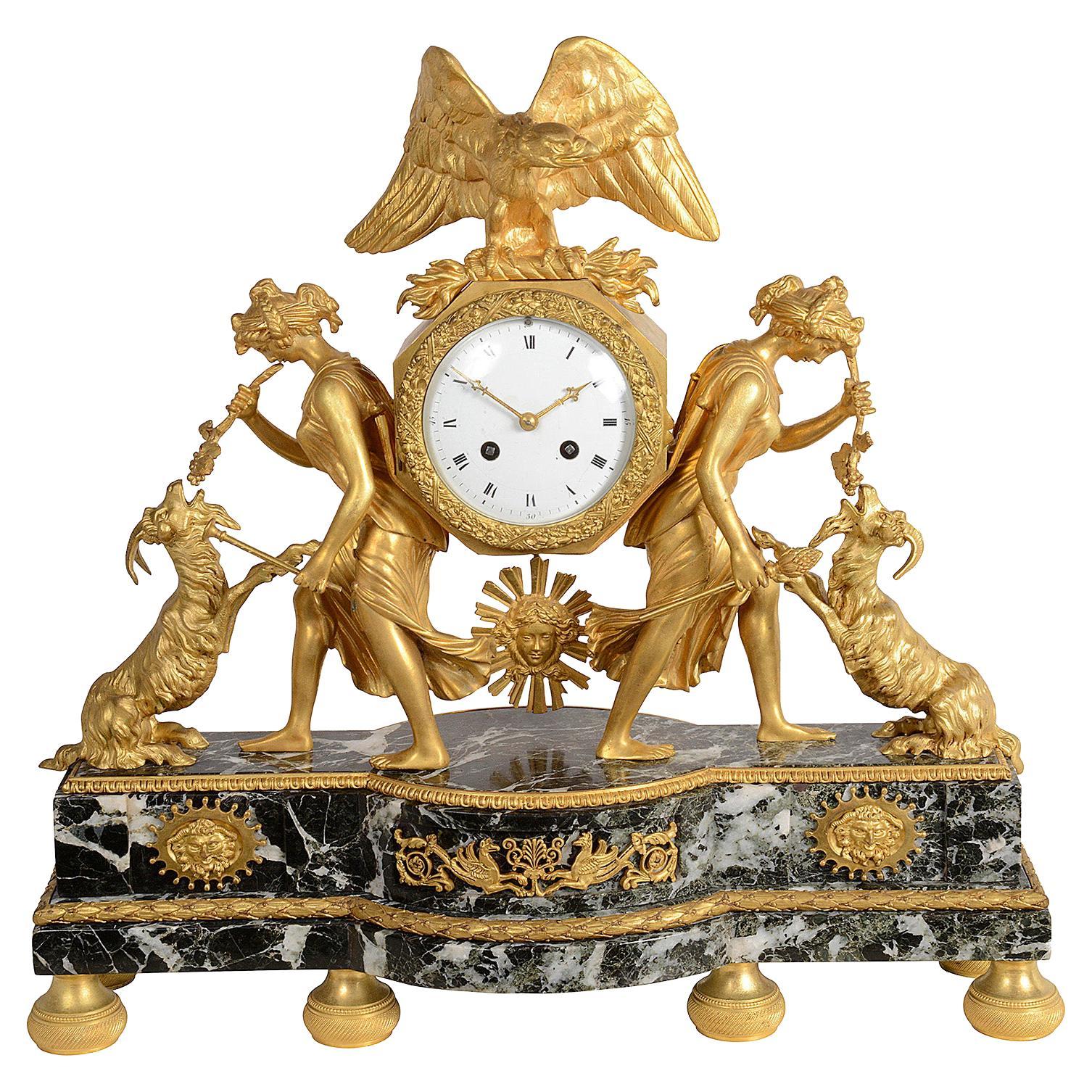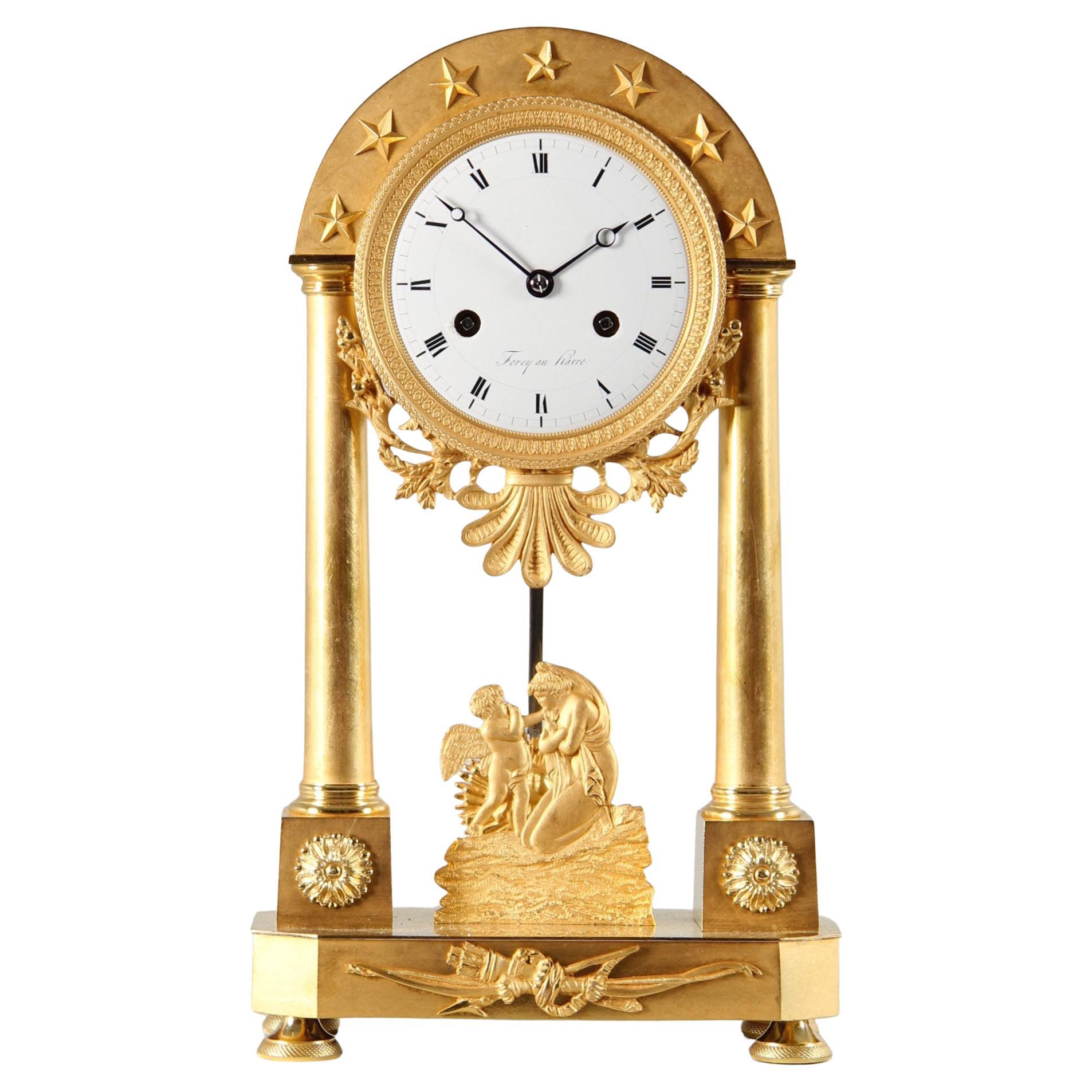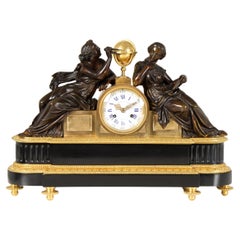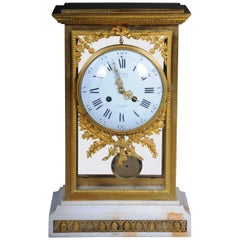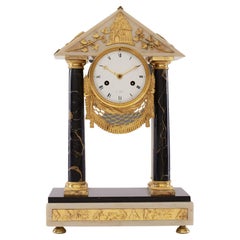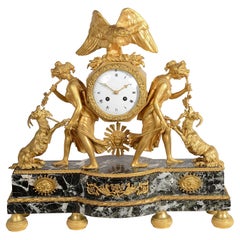Items Similar to 19th Century Mantel Clock "Astronomy", France circa 1830
Video Loading
Want more images or videos?
Request additional images or videos from the seller
1 of 22
19th Century Mantel Clock "Astronomy", France circa 1830
$4,707.84
£3,596.40
€4,000
CA$6,633.56
A$7,304.18
CHF 3,787.54
MX$86,501.63
NOK 48,080.39
SEK 44,936.57
DKK 30,472.77
About the Item
Antique mantel clock on the theme of astronomy
France
Bronze
Charles X around 1830
Dimensions: H x W x D: 48 x 19 x 10 cm
Description:
Unusual and beautifully crafted bronze mantel clock dedicated entirely to the theme of astronomy.
Dark patinated clockwork case in the form of a stele with a slightly protruding base section bordered by a palmette frieze.
Below the dial we see four putti in bas-relief, who are busy mapping the starry sky around a celestial globe.
Their tools such as compasses, rulers and protractors can also be found at the top as the crown of the clock. The neat workmanship of the bronze can be seen here, for example, in the fine hatching of the celestial globe, which can be clearly seen in one of the photos.
The bronzes were made by the Parisian bronzier Leclere, whose workshop is documented in the Rue Vieille Tacherie around 1850. His signature can be found not only on the bezel on the back, but also on other bronze parts and on the back of the dial. There is also an engraved date "1829".
The heart of the clock is a French pendulum movement with a 14-day power reserve, anchor escapement, locking disc striking mechanism and thread suspension of the pendulum. The silver-plated dial is typical of the era. The black numerals and Breguet hands ensure that the time is easy to read.
Condition:
Beautiful and authentic condition with slight signs of age in the patination and on the silvering of the dial. The movement has been completely dismantled and cleaned from top to bottom. It runs absolutely reliably and accurately.
- Dimensions:Height: 18.9 in (48 cm)Width: 7.49 in (19 cm)Depth: 3.94 in (10 cm)
- Style:Charles X (Of the Period)
- Materials and Techniques:
- Place of Origin:
- Period:
- Date of Manufacture:1829
- Condition:Repaired. Wear consistent with age and use. Beautiful and authentic condition with slight signs of age in the patination and on the silvering of the dial. The movement has been completely dismantled and cleaned from top to bottom. It runs absolutely reliably and accurately.
- Seller Location:Greven, DE
- Reference Number:1stDibs: LU5419238364732
About the Seller
5.0
Platinum Seller
Premium sellers with a 4.7+ rating and 24-hour response times
Established in 2014
1stDibs seller since 2020
207 sales on 1stDibs
Typical response time: 1 hour
- ShippingRetrieving quote...Shipping from: Münster, Germany
- Return Policy
More From This Seller
View All19th Century French Louis XVI Style "Astronomy" Mantel Clock, circa 1845
By Perrelet
Located in Greven, DE
French mantel clock "Astronomy"
Paris
Bronze, marble
Mid 19th century
Dimensions: H x W x D: 38 x 55 x 16 cm
Description:
A Louis XVI-style figural mantel clock mounted on a two-t...
Category
Antique 1840s French Louis XVI Mantel Clocks
Materials
Marble, Bronze
Early 19th Century French Mantel Clock, signed Ferey au Havre, Ormolu
Located in Greven, DE
Small mantel clock with bas-relief
France
Bronze, enamel
early 19th century
Dimensions: H x W x D: 33 x 19 x 9 cm
Description:
Antique, fire-gilt portal clock with figurative, Gre...
Category
Antique Early 19th Century French Empire Mantel Clocks
Materials
Bronze, Enamel, Ormolu
19th French Empire Mantel Clock, Pendule, Mercury, Gilded Bronze, circa 1815
Located in Greven, DE
19th century French pendule, mantel clock - Mercury the messenger of the gods
France
Bronze gilded
Empire around 1815
Dimensions: H x W x D: 37 x 30 x 10 cm
Description:
French Empire...
Category
Antique Early 19th Century French Empire Mantel Clocks
Materials
Bronze
French Empire Ormulu Bronze Mantel Clock, Lepaute, Thomire, Paris, circa 1815
Located in Greven, DE
Ormulu pendule with depiction of friendship and love
Paris (Lepaute, Thomire)
fire-gilt bronze
Empire around 1815
Dimensions: H x W x D: 44 x 36 x 13 cm
French pendulum movement with eight days duration. Thread suspension and lock disc striking movement with strike on bell on the half and full hour.
White enamel dial with Roman hour numerals and Breguet hands.
Signature: LePaute & Fils / Hrl. du Roi (Pierre-Basile Lepaute (1750 - 1843) with his son Pierre-Michel Lepaute (1785-1849); from 1811 in joint workshop).
Description:
The extremely high quality pendulum shown here takes up a profound theme: Friendship, which combines with love and can thereby outlast time and death. As it is typical for the epoch of classicism, personifications and symbols are taken from the fund of ancient mythology and art and then developed further.
The main figure is a young woman in an antique, girded garment, standing barefoot and with crossed legs next to an altar, on which she is leaning with her left elbow. She gracefully bows her head towards a tempestuously approaching Cupid, grasps his right hand with her left and draws him to her bosom, the seat of the heart. The delicate ambivalence of flying towards and being held culminates in the trustingly intimate look that the two cast at each other.
The young woman personifies friendship, the winged Cupid love. As a sign of their intimate connection, two burning hearts appear on the altar next to the two, framed by the puffed scarf, which are closely bound together by a chain of flowers.
Next to them, on the altar slab, one can see an erected book with the title "Amitie" (French: amitie, friendship). Supporting the book is a pomegranate held by a ring of pomegranate flowers. The bursting seeds spill out of the cracked skin. Since ancient times, the pomegranate and its blossoms have been dedicated to the goddess Persephone, symbolizing the underworld and death, but also life and fertility. The myrtle interwoven in the pomegranate flower wreath of "friendship" also has a far-reaching symbolic power: the plant was dedicated to the goddess Aphrodite, stands for virginity, and was and is therefore obligatory in the bridal wreath...
Category
Antique Early 19th Century French Empire Mantel Clocks
Materials
Bronze, Enamel
Early 19th Century French Empire Mantel Clock, Portal Pendule, Paris circa 1820
By Duval
Located in Greven, DE
Antique French round arch portal clock
France (Paris)
Bronze, enamel
Empire circa 1820
Dimensions: H x W x D: 47 x 26 x 12 cm
Description:
Very beautiful, strictly architecturally...
Category
Antique Early 19th Century French Empire Mantel Clocks
Materials
Bronze, Enamel
Early 19th Century Ormolu Mantel Clock, Atala freeing Chactas, Paris, circa 1810
Located in Greven, DE
Mantel Clock "Atala and Chactas"
Paris
Bronze (fire-gilt and patinated), enamel
Empire around 1810
Dimensions: H x W x D: 40 x 32 x 11 cm
Description:
Very rare and extremely high quality French mantel clock, so-called Pendule Au Bon Sauvage.
Depicted are scenes from the love story "Atala or the love of two savages in the desert" written by Francois René Vicomte de Chateaubriand in 1801. At the beginning of the 19th century, this was probably the most famous love story in Europe, but today it has been forgotten.
The story, set in present-day Louisiana (USA), is roughly rewritten about the forbidden love between Chactas, a young Indian, and Atala, the beautiful daughter of a Spaniard.
Chactas is captured in a battle between two Indian tribes, chained to a palm tree and is to be sacrificed. Atala wants to save his life and convert him to Christianity. She unties him from the palm tree at night and they flee together into the wilderness of North America. Their love for each other grows stronger and stronger and they have prospects for a future together.
The story takes a tragic turn when Atala, who must remain a virgin due to a vow made by her mother, can no longer withstand the conflict of her feelings and commits suicide.
The main group of characters thus shows Chacta's liberation through Atala. Atala is leaning against a pile of logs. The animal fur thrown over the logs and the weapons leaning against the stack on the right give the impression of a night camp.
The bronze is of rarely beautiful quality, finely chiselled and makes the scene appear very lively. The contrast of fire-gilded and patinated bronze adds tension to the composition.
In the base we see the Entombment as the end of the tragic love story. This bronze work is also very detailed, the interplay of bright and matt gilding makes the flat relief appear much deeper than it is.
The depiction of the mantel clock presented here shows that the exotic was only known from stories and that the bronzier had his own ideas about the appearance of this distant world. The Indian, for example, has very European facial features and his skin was not black in reality, of course. The palm tree was also certainly not found in the North American wilderness.
The heart of the clock is a French pendulum movement, integrated into the wooden pile, with an eight-day power reserve and a lock plate striking a bell on the half and full hour. The pendulum is suspended on a thread, typical of the period. The classically shaped hands, so-called Breguet hands, are also typical of the time.
The enamelled dial has black Roman hour numerals, Arabic quarter hours and bears the signature: Le Roy hr. de Madame A PARIS.
Interesting facts:
The period from 1795 to about 1815 saw the creation of probably the most spectacular group of bronzes: The "Au bon Sauvage" pendulums - depictions of the "Noble Savage".
Today's viewers react to these objects with both fascination and irritation. Enthusiastic on the one hand about the obvious quality of the detailed bronzes and the allure of the exotic, on the other hand distanced and cautious because of the possible discrimination that is suspected behind them. The ambivalence of this feeling motivates the search for the conditions of origin of these pendulums.
Europeans found their new ideal of the natural man primarily in fictional and realistic travelogues about the Indians of North America...
Category
Antique Early 19th Century French Empire Mantel Clocks
Materials
Ormolu
You May Also Like
Antique French Mantelpiece / Clock, Deniere a Paris, circa 1880
Located in Berlin, DE
Antique French mantelpiece / clock, Deniere a Paris, circa 1880
All-round glazed, fire-gilded bronze case with relief decoration, on an alabaster ba...
Category
Antique 1880s French Table Clocks and Desk Clocks
Materials
Marble, Brass
Mantel Clock 19th Century Louis XV Period
Located in Warsaw, PL
An exquisite 19th-century Louis XV-style mantel clock, showcasing a harmonious blend of Neoclassical and Rococo influences. This elegant timepiece features a finely crafted white ena...
Category
Antique Late 18th Century French Louis XV Mantel Clocks
Materials
Marble, Bronze
Early 19th Century French Empire Period Portico Clock
Located in Dublin, IE
A fine early 19th century French Empire period Portico clock of exceptional quality in the Neo-classical style, the clock housed in a richly figured mahogany case with four tapering ...
Category
Antique Early 19th Century French Empire Mantel Clocks
Materials
Ormolu
French Empire Style Mantel Clock, circa 1820
Located in Brighton, Sussex
A very impressive and stylish early 19th Century gilded ormolu and green marble mantle clock, having two classical maidens either side feeding Rams, an Eagle above the circular white...
Category
Antique Early 19th Century French Empire Mantel Clocks
Materials
Marble, Ormolu
French Portico Clock Signed Cellier à Paris, 19th Century
Located in Greding, DE
Small portico clock made of gray marble with gilded applications. The cylindrical movement is enclosed between two columns, above which a figural top piece in the form of a seated Ch...
Category
Antique 19th Century French Empire Table Clocks and Desk Clocks
Materials
Marble, Bronze, Enamel
19th Century French Neoclassical Mantel Clock with Ormalu
Located in Atlanta, GA
A large Neoclassical mantle clock in brass with ormalu mounts, urn and swag detail.
William Word Fine Antiques: Atlanta's source for antique in...
Category
Antique 19th Century French Clocks
Materials
Brass
More Ways To Browse
Breguet Antique
Breguet Numerals
Celestial Globe
Antique Celestial Globe
Crown Clock
French Clock Movement
Antique French Clock Movement
Clock Heart
Antique Protractors
Kienzle Table Clock
Small Table Clock
Desk Barometer
Vintage Metal Alarm Clock
17th Antique Clock
French Clock Makers
Novelty Clocks
Vintage Alarm Clock Germany
Antique Bell Pull
